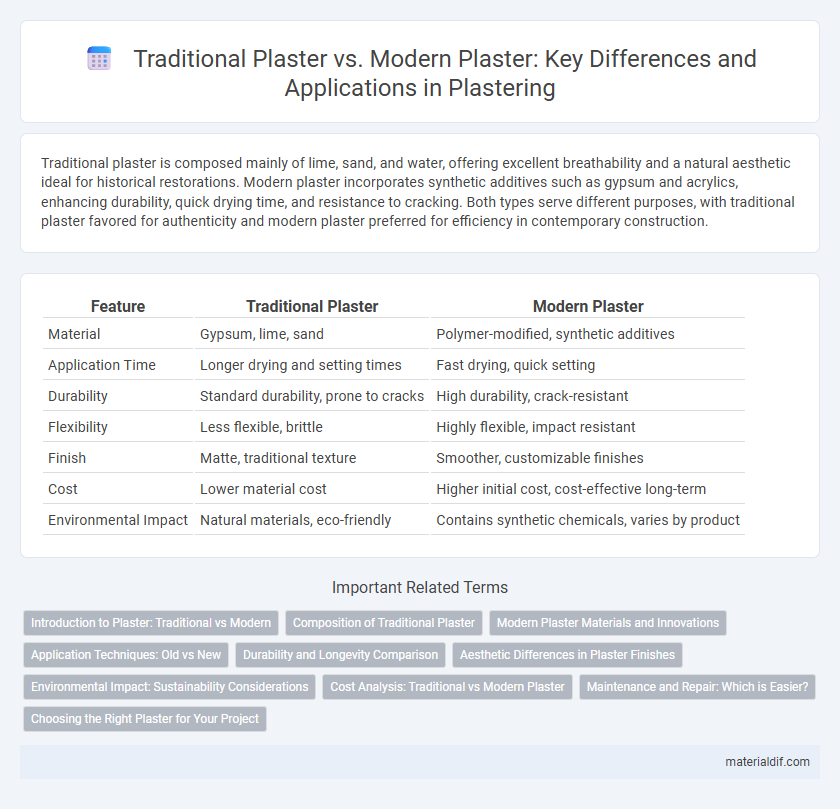Traditional plaster is composed mainly of lime, sand, and water, offering excellent breathability and a natural aesthetic ideal for historical restorations. Modern plaster incorporates synthetic additives such as gypsum and acrylics, enhancing durability, quick drying time, and resistance to cracking. Both types serve different purposes, with traditional plaster favored for authenticity and modern plaster preferred for efficiency in contemporary construction.
Table of Comparison
| Feature | Traditional Plaster | Modern Plaster |
|---|---|---|
| Material | Gypsum, lime, sand | Polymer-modified, synthetic additives |
| Application Time | Longer drying and setting times | Fast drying, quick setting |
| Durability | Standard durability, prone to cracks | High durability, crack-resistant |
| Flexibility | Less flexible, brittle | Highly flexible, impact resistant |
| Finish | Matte, traditional texture | Smoother, customizable finishes |
| Cost | Lower material cost | Higher initial cost, cost-effective long-term |
| Environmental Impact | Natural materials, eco-friendly | Contains synthetic chemicals, varies by product |
Introduction to Plaster: Traditional vs Modern
Traditional plaster, composed of lime, sand, and water, offers breathability and natural moisture regulation, making it ideal for historic building restoration. Modern plaster often uses gypsum or cement-based compounds, providing faster drying times, enhanced durability, and compatibility with contemporary construction methods. Choosing between traditional and modern plaster depends on the substrate, environmental conditions, and desired finish quality.
Composition of Traditional Plaster
Traditional plaster primarily consists of lime, sand, and water, creating a breathable and flexible mixture ideal for historic building restoration. This composition allows moisture to evaporate naturally, preventing damage caused by trapped dampness. The slow curing process of lime-based plaster also enhances durability and resistance to cracking compared to modern gypsum-based alternatives.
Modern Plaster Materials and Innovations
Modern plaster materials incorporate advanced synthetic polymers and lightweight aggregates, offering enhanced durability, flexibility, and moisture resistance compared to traditional lime or gypsum-based plasters. Innovations such as fiber-reinforced composites and quick-setting formulations improve application efficiency and structural performance in both interior and exterior surfaces. These advancements contribute to sustainable building practices by reducing environmental impact and increasing the lifespan of plastered surfaces.
Application Techniques: Old vs New
Traditional plaster involves the manual application of lime or gypsum mixtures using trowels and hawks, relying heavily on skilled craftsmanship for layering and curing. Modern plaster incorporates advanced tools like spray machines and premixed compounds, enabling faster, more uniform application with enhanced adhesion and durability. Innovations in modern plaster techniques improve efficiency, reduce labor costs, and offer superior finish consistency compared to traditional methods.
Durability and Longevity Comparison
Traditional plaster, composed mainly of lime and sand, offers excellent breathability and flexibility but tends to be more susceptible to cracking and damage over time. Modern plaster formulations, often incorporating gypsum and synthetic additives, provide enhanced durability, faster drying times, and greater resistance to impact and moisture. In terms of longevity, modern plaster generally outperforms traditional plaster in high-traffic or damp environments, ensuring extended structural integrity and reduced maintenance costs.
Aesthetic Differences in Plaster Finishes
Traditional plaster offers a rich, textured finish characterized by natural imperfections and hand-applied artistry, creating unique, warm surfaces often sought in period restoration. Modern plaster provides a smoother, more uniform appearance due to advanced materials and application techniques, allowing for sleek, contemporary designs with enhanced durability. The aesthetic differences highlight traditional plaster's organic charm versus modern plaster's clean, minimalist appeal, influencing architectural styles and interior design choices.
Environmental Impact: Sustainability Considerations
Traditional plaster, typically made from natural materials like lime and clay, offers excellent sustainability benefits due to its biodegradability and low embodied energy. Modern plaster often relies on synthetic additives and gypsum, which can have a higher environmental footprint through mining and chemical processing. Choosing traditional plaster can reduce environmental impact by enhancing indoor air quality and reducing carbon emissions associated with production and disposal.
Cost Analysis: Traditional vs Modern Plaster
Traditional plaster typically incurs higher labor costs due to its lengthy application and curing times, while modern plaster often reduces overall expenses with faster drying and simpler application techniques. Material costs for traditional plaster may be lower, but the extended project duration can increase total expenditure. Modern plaster solutions often provide cost efficiency by minimizing labor hours and reducing material wastage, making them a financially viable option for many construction projects.
Maintenance and Repair: Which is Easier?
Traditional plaster, composed mainly of lime and sand, often requires careful patching to match its texture and finish, making maintenance and repairs more labor-intensive. Modern plaster, typically gypsum-based, offers easier and faster repairs due to its uniform consistency and quicker drying times, allowing for seamless touch-ups with standard materials. Homeowners and contractors prefer modern plaster for lower maintenance demands and efficient repair processes, especially in high-traffic or moisture-prone areas.
Choosing the Right Plaster for Your Project
Traditional plaster, made from lime, sand, and water, offers excellent breathability and durability, making it ideal for heritage restoration and older buildings. Modern plaster, often gypsum-based, provides faster drying times, smoother finishes, and increased ease of application suitable for contemporary construction projects. Selecting the right plaster depends on factors like building type, desired finish, environmental conditions, and project timeline to ensure optimal performance and longevity.
Traditional Plaster vs Modern Plaster Infographic

 materialdif.com
materialdif.com